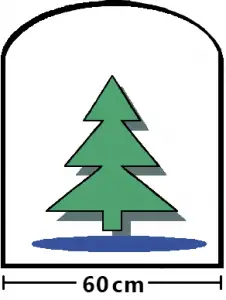The exercise of differential of differential calculus is the next
A window has the shape of a square crowned by a semicircle. The base of the window is measured as having a width of 60 cm, with a possible error in the measurement of 0.1 cm. Use differentials to calculate the maximum error when calculating the area of the window in order to have the beautiful view of the pine.

The exercise is quite simple to solve, as seen in the figure of the window, it is a square with a semicircular crown, once we have already been clear that, we will write our data:
l = 60 cm \qquad r = \cfrac{l}{2} \qquad dl = 0.1 cm
As can be seen, l was named as the side of the square, the radius measures half of the side of the square and the differential of dl is the possible error in the measurement that mentions the problem.
What we want to calculate is the maximum error in the area, so we have to resort to the square area formula and the semicircle area formula:
A_{\square} = l^{2} \quad A_{\frac{\bigcirc}{2}} = \cfrac{\pi r^{2}}{2}
Since the area of the window includes the square and the semicircular crown, we can add the two areas that we wrote earlier:
A_{T} = l^{2} + \cfrac{\pi r^{2}}{2}
It will be a bit complicated to work with so many variables, so what we will do is leave the expression in terms of the side l, replace r=\frac{l}{2}
A = l^{2} + \cfrac{\pi \left(\frac{l}{2}\right)^{2}}{2} = l^{2} + \cfrac{\pi\left( \frac{l^{2}}{4} \right)}{2}
A = l^{2} + \cfrac{\pi l^{2}}{8}
Now that we have the area in terms of the side l, we can proceed to derive. Derivative of l^{2} equals [katex2]l\ dl[/katex], replace:
dA = 2l \ dl + \cfrac{\pi}{8} (2l \ dl)
We can simplify the fraction of denominator 8 and factor dl:
dA = \left( 2l + \cfrac{\pi}{4} l \right) \ dl
Now that we have all the derivative expression, we can replace the values of l with 60 and dl with 0.1:
dA = \left[ 2(60) + \cfrac{\pi}{4}(60) \right] \left(0.1 \right)
By performing the operations we will have the following expression:
dA = \left( 12 + \cfrac{3}{2} \pi \right) \ cm^{2}
Finally we solve to obtain the following result:
dA \approx 16.71 \ cm^{2}
The maximum error when calculating the area of the window using differential calculus is 16.71\ cm^{2}!
Thank you for being at this moment with us : )
